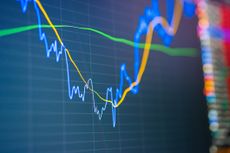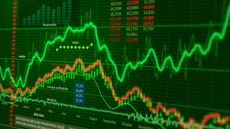The 8% Solution
What rate of return should investors expect these days?

There's a popular tool at Kiplinger.com that lets you figure out whether you're saving enough for retirement. All you do is plug in key information about your salary and savings, along with "the number," the rate at which you expect your money to grow (you can choose 6%, 8% or 10%). Back in the day, few people would have disagreed if you assumed that you could earn the historical return of roughly 10% a year, including dividends, by investing in stocks.
But then came the decade of the aughts, when the overall return for Standard & Poor's 500-stock index was less than aught (-0.95% annualized for the ten years ended December 31, 2009). And now we're in the tenuous teens, when the shock waves from a Grecian burn and trading turbulence on Wall Street can send the market down hundreds of points in the blink of an eye.
(Investors, as evidenced by reader comments on recent Kiplinger articles aimed at both younger investors with decades to save and older workers trying to catch up to retirement, are understandably dialing back their expectations.)

Sign up for Kiplinger’s Free E-Newsletters
Profit and prosper with the best of expert advice on investing, taxes, retirement, personal finance and more - straight to your e-mail.
Profit and prosper with the best of expert advice - straight to your e-mail.
What return should investors expect in the decade ahead? Jeremy Grantham, chief investment strategist for GMO, predicts that a mix of global stocks and what he calls U.S. high-quality blue chips -- those with high returns on equity, low earnings volatility and low leverage -- will return about 8.3% (including inflation of 2.5%) on an annualized basis. But he has significantly lower expectations for other stocks in the S&P 500.
Among market optimists, Kiplinger's columnist Jeremy Siegel predicts that rising profits could result in a real return of 7% -- or close to the historical range of 9% to 10% if you assume inflation of 2% to 3% per year.
We offer our own midyear outlook in our July 2010 cover story. Over the long term, Kiplinger contributing economist Richard DeKaser thinks 7% is realistic (including an inflation factor). And if the stock market is undervalued, as DeKaser suspects it may be, returns could be as high as 8% or 9% over the next decade. (Read An Insider's View of the Economy, from our July 2010 issue, for more of his economic outlook.)
Meanwhile, executive editor Manny Schiffres points out that returns over any ten-year period depend on your starting point. From the vantage point of March 2019, precisely a decade after the recent bear-market low, the ten-year return could be "quite impressive," says Manny.
Gun-shy investors. But there's also a psychological factor, and investors can be forgiven for being wary. In the Thrivent Financial/Kiplinger Survey of Family Finances, nearly three-fourths of those interviewed said recent market volatility has affected the way they handle money, and 55% said they are less willing to take risks. (See the eight threats to the bull market).
So what number should you plug into that retirement calculator? For young people in their twenties whose retirement stash is primarily in stocks, the historical annual return of roughly 10% isn't out of the question. But nobody would accuse you of being imprudent if you assumed an 8% return for the long term -- or 6% for the years leading up to retirement. Just remember that cutting back too much on stocks exposes you to the risk that your savings won't keep up with inflation or that you'll outlive your money. If you had panicked and sold at the bottom of the bear market, you would have missed out on a remarkable surge in stock prices. Through May 10, stocks were up 76% from the market bottom. Now that's a number worth remembering.
P.S. After you've used our savings calculator, pick up a copy of Kiplinger's Retirement Planning 2010, a rich package edited by senior editor Mary Beth Franklin.

Janet Bodnar is editor-at-large of Kiplinger's Personal Finance, a position she assumed after retiring as editor of the magazine after eight years at the helm. She is a nationally recognized expert on the subjects of women and money, children's and family finances, and financial literacy. She is the author of two books, Money Smart Women and Raising Money Smart Kids. As editor-at-large, she writes two popular columns for Kiplinger, "Money Smart Women" and "Living in Retirement." Bodnar is a graduate of St. Bonaventure University and is a member of its Board of Trustees. She received her master's degree from Columbia University, where she was also a Knight-Bagehot Fellow in Business and Economics Journalism.
-
 Strategies to Optimize Your Social Security Benefits
Strategies to Optimize Your Social Security BenefitsTo maximize what you can collect, it’s crucial to know when you can file, how delaying filing affects your checks and the income limit if you’re still working.
By Jason “JB” Beckett Published
-
 Don’t Forget to Update Beneficiaries After a Gray Divorce
Don’t Forget to Update Beneficiaries After a Gray DivorceSome states automatically revoke a former spouse as a beneficiary on some accounts. Waivers can be used, too. Best not to leave it up to your state, though.
By Andrew Hatherley, CDFA®, CRPC® Published
-
 Stock Market Today: Dow Slips After Travelers' Earnings Miss
Stock Market Today: Dow Slips After Travelers' Earnings MissThe property and casualty insurer posted a bottom-line miss as catastrophe losses spiked.
By Karee Venema Published
-
 Stock Market Today: Stocks Stabilize After Powell's Rate-Cut Warning
Stock Market Today: Stocks Stabilize After Powell's Rate-Cut WarningThe main indexes temporarily tumbled after Fed Chair Powell said interest rates could stay higher for longer.
By Karee Venema Published
-
 Stock Market Today: Stocks Reverse Lower as Treasury Yields Spike
Stock Market Today: Stocks Reverse Lower as Treasury Yields SpikeA good-news-is-bad-news retail sales report lowered rate-cut expectations and caused government bond yields to surge.
By Karee Venema Last updated
-
 Stock Market Today: Nasdaq Leads as Magnificent 7 Stocks Rise
Stock Market Today: Nasdaq Leads as Magnificent 7 Stocks RiseStrength in several mega-cap tech and communication services stocks kept the main indexes higher Thursday.
By Karee Venema Published
-
 Stock Market Today: Stocks Tumble After a Hot Inflation Print
Stock Market Today: Stocks Tumble After a Hot Inflation PrintEquities retreated after inflation data called the Fed's rate-cut plans into question.
By Dan Burrows Published
-
 Stock Market Today: Stocks End Mixed Ahead of Key Inflation Reading
Stock Market Today: Stocks End Mixed Ahead of Key Inflation ReadingEquities struggled before tomorrow's big Consumer Price Index report.
By Dan Burrows Published
-
 Stock Market Today: Stocks Closed Mixed in Choppy Trading
Stock Market Today: Stocks Closed Mixed in Choppy TradingVolatility returned as market participants adjusted their expectations for rate cuts.
By Dan Burrows Published
-
 Stock Market Today: Stocks Rally After Blowout Jobs Report
Stock Market Today: Stocks Rally After Blowout Jobs ReportStocks soared into the weekend as investors brushed off strong payrolls data and lowered rate-cut expectations.
By Dan Burrows Published